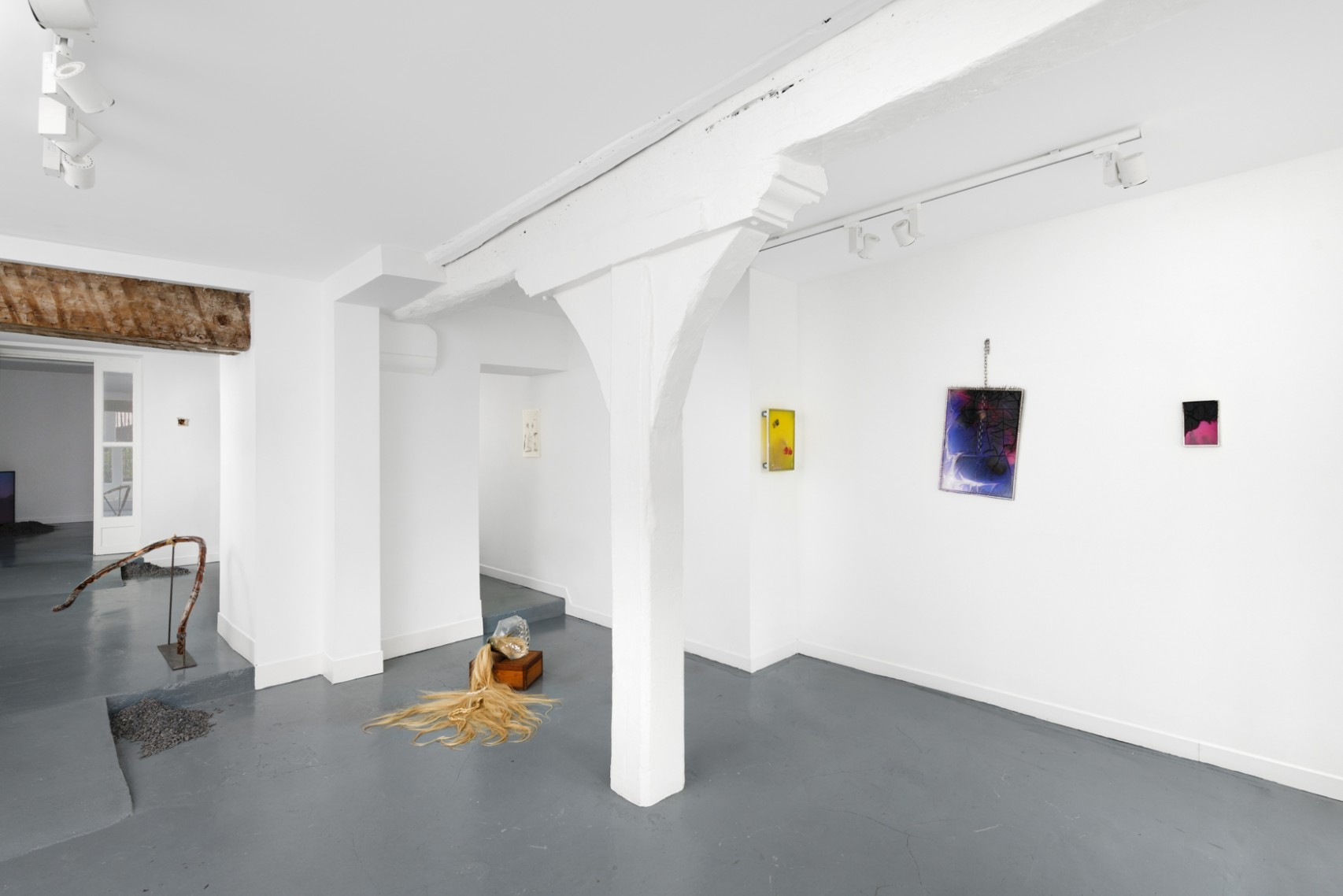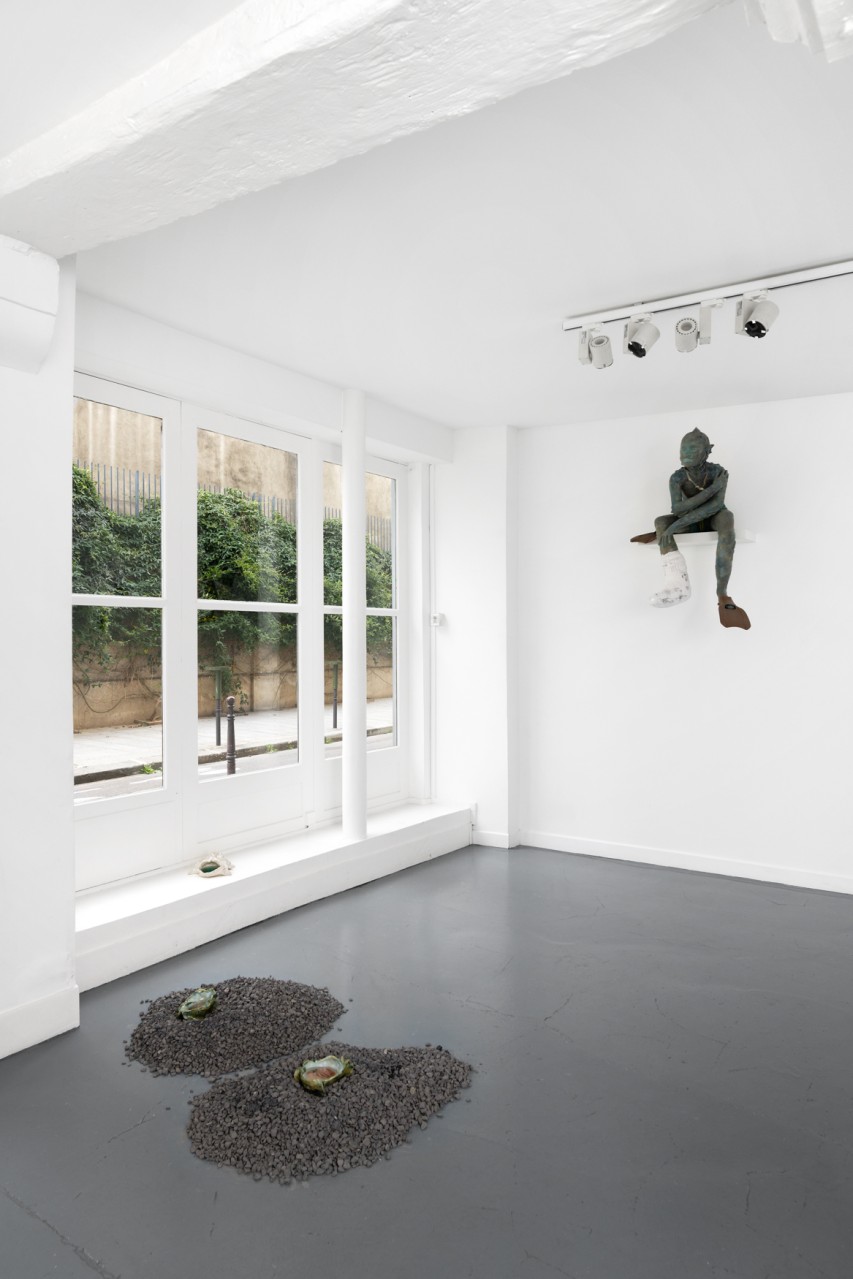
- Odyssea : Acte II - Nina Boughanim - Michele Gabriele - Brandon Gercara - Laura Gozlan - Samir Laghouati Rashwan - Valentin Vert
- Marilou Poncin
- Gaby Sahhar
Odyssea - Acte II : Le sel de la terre

Exhibition view, Odyssea - Acte II : Le sel de la terre, spiaggia libera, Paris, France, 2024. Photo © Aurélien Mole
After a phantasmagorical journey from the ocean depths to the surface of the earth, from the mythical fish-woman to a contemporary emancipated figure during the first Marseillaise edition of Odyssea – The Song of the Sirens – a nebulous, post-capitalist world now emerges, inhabited by creatures seeking change. “The Salt of the Earth” thus proposes exploring a different space-time, one that is hard to place in a linear history and resembles a narrative of anticipation. Salt, known for its corrosive and purifying properties, materializes here as piles of charred debris within which the artists’ works unfold.
Now reduced to an underground existence, the remnants of our societies survive beneath these vestiges. Objects from our era scatter the ground, mingling with those from a future that unfolds within the earth’s bowels. The last habitable space, the hollow of the world, shelters the traces of our civilizations. Ex-votos – relics of ancestral rituals whose meanings are now lost – mix with technological tools whose functions elude us. These scattered ruins, containing fragments of a vanished humanity, litter a black rocky ground that invades the gallery space. Visitors are invited to walk across this soot-covered surface, a symbol of a world in ashes, yearning for regeneration.

Exhibition view, Odyssea - Acte II : Le sel de la terre, spiaggia libera, Paris, France, 2024. Photo © Aurélien Mole
Samir Laghouati-Rashwan, Screw House, 2024, resin, aluminium frame, laser printing, stainless steel chain, 41 x 61 cm. Courtesy the artist. Photo © Aurélien Mole
Valentin Vert, Naphtex Kerogen (ou les remords de Prométhée), 2024, bitumen, stainless steel, argand spout, kerosene, water, 150 x 80 x 80 cm. Courtesy the artist. Photo © Aurélien Mole
From this earthly abyss emerge fragments of different narratives and eras, intertwined. Samir Laghouati-Rashwan’s pieces serve as a condensation of what once existed in the world before. Archive images from various sources, containing stories of societal, political, or historical events, his works resonate like remnants of a lost universe.
Meanwhile, Valentin Vert’s oil lamp conveys a formal ambivalence between an ancient mechanism from the era of the working-class mines and a futuristic device with inscrutable properties. Through its industrial character and apparent technicality, it becomes the conductor of buried stories, prompting reflection on the future of fossil fuels and the inevitable combustion of the earth.

Exhibition view, Odyssea - Acte II : Le sel de la terre, spiaggia libera, Paris, France, 2024. Photo © Aurélien Mole

Exhibition view, Odyssea - Acte II : Le sel de la terre, spiaggia libera, Paris, France, 2024. Photo © Aurélien Mole
Marilou Poncin, sleepy in a ray skeleton, 2024, enamelled ceramic, photo printing and resin, 30 x 24 x 14 cm. Courtesy the artist & spiaggia libera, Paris. Photo © Marilou Poncin
Having returned from the depths – the original lair of the sirens – Michele Gabriele’s triton serves as a bridge between the two acts. Present in both exhibitions, it gazes impenetrably upon the state of a world in free fall. Nina Boughanim’s sculpture, meanwhile, lies on the ground like a stranded creature. Combining found objects and feminine accessories that give it an organic dimension, it transforms into a mythical relic, echoing her prophetic dreamlike engraving.
Finally, Marilou Poucin’s seashells reveal female figures, most often from the digital world. The enamelled shells or teeming forms encasing them act as temporal portals, offering glimpses of images from beyond.

Exhibition view, Odyssea - Acte II : Le sel de la terre, spiaggia libera, Paris, France, 2024. Photo © Aurélien Mole
Complementing the Marseillaise chapter, where aquatic creatures reigned, the moment of the world’s metamorphosis and the tipping point of a civilization is illuminated here before the debris gives way to new forms of life. This is how Bloom, the character embodied by Brandon Gercara, rises from the ashes of the Piton de la Fournaise, Réunion Island’s still-active volcano. This awakening – followed by a tentative march through this deserted landscape, accompanied by a voice-over text – is also the artist’s way of addressing the struggles faced by the LGBTQI+ community in Réunion.
From another perspective, Gaby Sahhar’s painting Transitional reveals a faceless being, stripped of any gender or sex assignment, evoking identity questions while also sketching possible evolutions or transcendence of the human in the centuries to come. Laura Gozlan’s sculptures depict external organs resonating with the sounds of a video game acting as a pulsating louse. A seeping ribcage, a vibrating sculpture echoes sinuous forms filled with cables and freeze-dried marine animal fragments, suggesting enigmatic circulatory networks.
On the ashes of our past, mutant bodies in gestation sprout, seemingly foreshadowing the future of humanity, thus bringing the second act of Odyssea to a close.
— Camille Velluet
Laura Gozlan, Inner chains #7, 2018, plexiglas pipes, epoxy, ginseng, dried octopus, usb cables, aluminum, batteries, latex tourniquet, iron stand, 130 x 90 x 50 cm. Courtesy the artist & Valeria Cetraro.
Gaby Sahhar, Transitional, 2023, oil paint, oil stick, graphite on canvas, 55 x 45 cm. Courtesy the artist & spiaggia libera, Paris. Photo © Aurélien Mole














